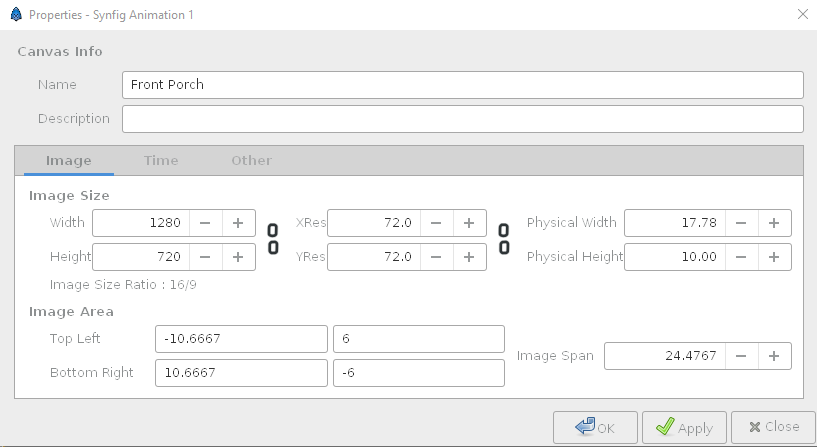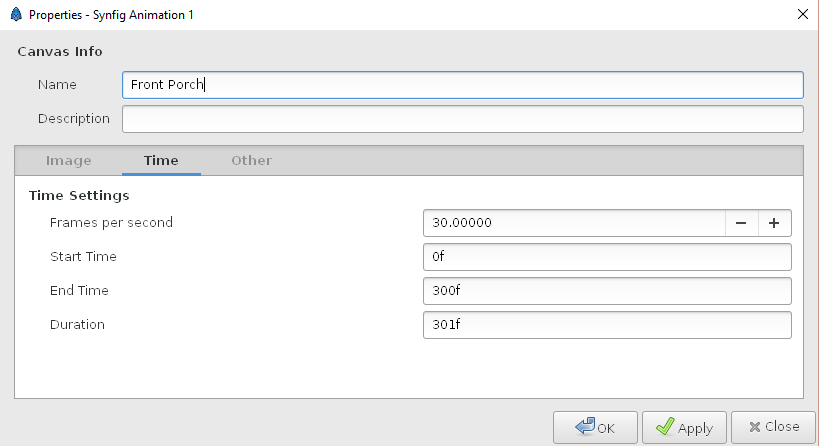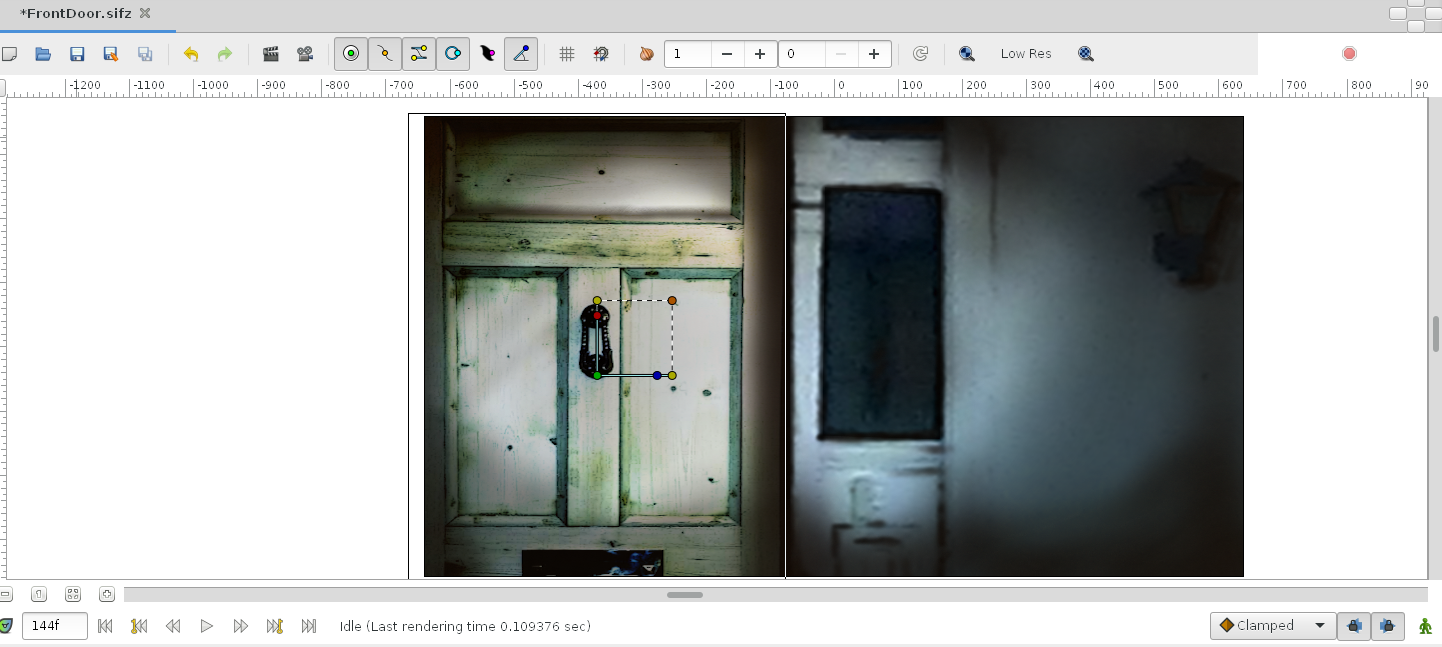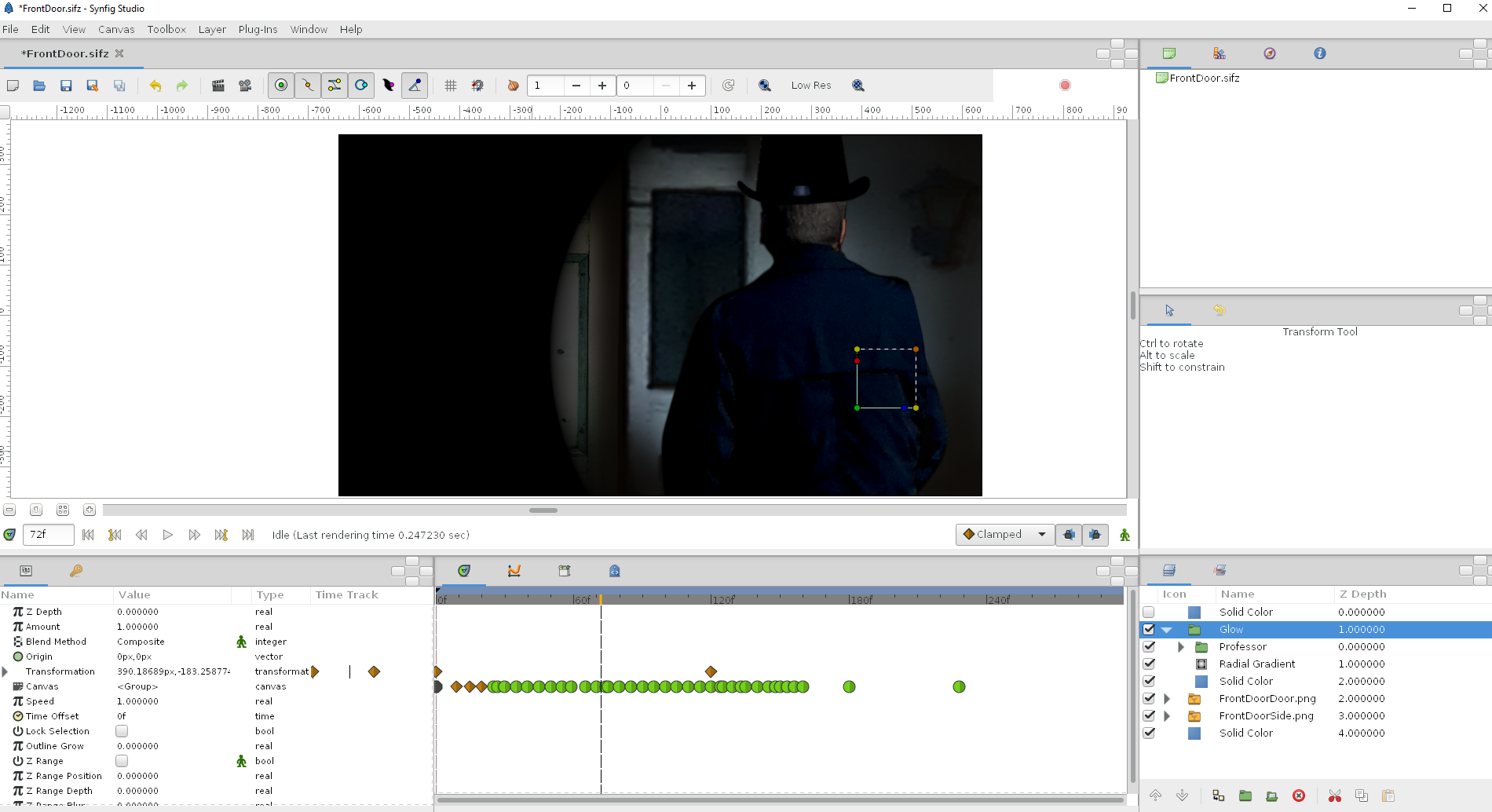With the backdrops pretty much ready to go, with the exception of the fireplace, which needs some serious shadows, I’ve been looking at the animation side of things.
Nothing gets stuff done like getting stuff started, eh?
Synfig
Opening up Synfig, I set the dimensions to 1280 x 720, which gives a 16 : 9 ratio, ready to go.

Now, the scenes are to be slow and progressive so, unlike Adaptation which was more a collection of conceptual shots, I’ll be looking for a lengthy time span of about ten seconds. At a frame rate of 30 fps, that’s, uh, wait, let me get my calculator out… carry the 1… 300 frames.

Hit the OK button and get ready to rumble.
I start by adding a flat colour for the background. Black is good, considering the number of shadows. Why do I need a background if I’ve got a backdrop? If any part of the backdrop image happens to be transparent, or if I use a layer over the top which modifies the alpha of the backdrop, I don’t want to make sure it doesn’t use white or something to compensate.
Anyway, with that in place, I add the backdrop of the door frame (taken from the actual cover. Yes, it’s grainy. Yes, it’s dark. That’s ok. The scene is at night, and it’s going to be a bit further away than our Professor, anyway. The door, however, is sharp. This is where the Professor will be spending some time opening up the lock.
So I insert the door and, presto, I’ve got a front porch!

Props
Now I want to be able to move things about. I want the Professor to walk from the right, over to the door while chatting to the protagonist, unlock the door and open it. And for extra focus and ‘night time’ness, I want there to be some evidence of a lantern.


I’ve broken up the Professor into two main parts: his arm, which will move about to give an impression that he’s not just a cardboard cutout, and his torso. Both the arm and torso will belong to a group so that, as the Professor ‘walks’, the arms and torso bob at the same rate.

I’ve added the ‘lantern’ to the Professor group, so that it, too, moves along with the body. It’s really just a shroud, a radial gradient of zero-alpha to full, with a heavy offset, such that everything outside of the lantern’s influence is dark.
You’ll note, on the time line there, the bunch of green dots. This is the motion of the Professor, stepping and bobbing along. The green is Synfig’s TCB waypoint inference. It gives a looser waypoint than clamped or ease. If I set them all to linear or clamped, the Professor would be marching like a soldier. As it is, his gait is more natural.
All that’s left to do now it animate the door opening, add in a warm ‘lantern’ glow to the radial gradient and shade the door more as it opens to give an impression of darkness and depth.
Sound
There are three key sounds in this scene:
- The Professor nattering to the Protagonist about it being dry on the porch.
- The key turning and the door opening.
- The ambient rain, a crucial element of the story.
Getting the key and lock sound was fairly simple. I went out the back to the gate and practiced with the slide bolt. A few trial runs and I recorded it on my phone, picked the best sounding one and cleaned it up in Audacity. More on the cleaning-up bit later.
The voice was more difficult. Where, oh, where does one find a Victorian Professor in the middle of outer Melbourne suburbia? I tried a few online services, but I couldn’t get the voice actor I was after. The ‘British’ was either too uppety, too young, too old or, in most cases, too damned expensive. I’m working on a shoe-string, here.
Fiverr looked promising. There are a lot of voice over artists who are willing to lend their talents. Checking through the various videos and samples, though, it seems it’s mostly geared toward reading scripts for advertisements. Not what I’m after.
In the end, I put on my best ‘old-but-not-too-old’ British accent, practiced again and again and again. And again. Then recorded myself. Yeah. That’s what I did. I hope it sounds right. You know when you hear your voice on tape and you think, “Heck, is that me?”
Lastly, the rain. I haven’t got that sound clip yet. I’m expecting it to rain here in Fawkner tomorrow, and I’ve got a nice corrugated iron cantilever out the side that should sound awesome.
Anyway, back to Synfig: I tried adding these sounds as ‘sound layers’. That is, one adds a layer of type ‘sound’, points the sound file to the .wav or .mp3 and then set the offset.

This seemed the perfect way to add sound to the clip apart from two things.
Firstly, it didn’t always play. Every so often, when re-running the clip, I’d have to select the layer to give it a poke, and the sound would then play. OK, no biggy. So long as it exports…
It didn’t export. No matter what format I exported it as, the sound didn’t come through in the final file. I vaguely remember having this issue with The Bullet. My solution there was to add the sound when assembling the final video. I guess I’ll have to do the same thing here.
More on the sound and Audacity in the next post.

